You’ll find them in nearly any department store or gas station: Fidget spinners, fidget cubes, and other devices designed to help you focus. There’s no scientific evidence about whether they work, but that’s about to change, thanks for a new study by researchers at UC Santa Cruz and the UC Davis MIND Institute.
你几乎在任何一家百货公司或加油站都能找到它们:指尖陀螺、指尖立方体,以及其他旨在帮助你集中注意力的玩意儿。目前还没有科学证据表明它们是否有效,但这种情况即将改变,这要感谢加州大学圣克鲁兹分校(UC Santa Cruz)和加州大学戴维斯心理研究所(UC Davis MIND Institute)的研究人员所做的一项新研究。

“We need science to weigh in on whether these devices can help, and how,” said Julie Schweitzer, professor of psychiatry and behavioral sciences at the UC Davis MIND Institute and the lead investigator on the project. “ADHD is associated with lower income, job instability, higher substance abuse and accident rates, and more.”
“我们需要科学权衡这些物件是否有用,以及如何作用,”加州大学戴维斯精神研究所的精神病学和行为科学教授Julie Schweitzer说,她也是该项目的首席研究员。“多动症与收入较低、工作不稳定、较高药物滥用率和事故率等因素有关。”
Schweitzer said anxiety surrounding COVID-19 and working or attending school from home is a challenge, and the study has implications for how fidget devices might ease anxiety as well as increase focus.
Schweitzer说,COVID-19引发的焦虑对在家工作或学习是个挑战,这项目研究此类指尖物件如何缓解焦虑,并提高注意力。
“People are expected to be paying attention to virtual meetings for hours, and anything you can do to help improve people’s attention, alertness and emotional regulation could be helpful,” added Schweitzer.
Schweitzer补充道:“人们被期望在虚拟会议上花上好几个小时的时间,你所做的任何有助于提高人们注意力、警觉性和情绪调节的事情都是有帮助的。”
The research team is recruiting 110 adults with Attention Deficit Hyperactivity Disorder (ADHD). Participants will perform attention and memory tasks and be shown film clips to evoke an emotional response. The team will study natural physical movements, or fidgeting, in addition to giving some participants a specially designed “smart” fidget ball developed at UC Santa Cruz to squeeze, stroke, or tap.
研究小组招募了110名患有注意力缺陷多动障碍(ADHD)的成年人。参与者将执行注意力和记忆任务,并观看电影片段以唤起情感反应。研究小组将研究身体的自然运动,也就是指尖,除此之外,还会给一些参与者一个由加州大学圣克鲁斯分校特别设计开发的“智能”指尖球,让他们可以挤压、击打或敲击。
The fidget ball — a silicon skeleton with a soft fabric cover — will measure each of those movements using internal sensors. The data are transmitted in real-time to a computer for analysis.
这个指尖球由硅骨架和柔软的织物包裹而成,它将通过内部传感器来测量每一个动作。数据被实时传输到计算机进行分析。
“The sensors measure not only when someone touches them, but how much pressure is used,” said co-investigator Katherine Isbister, a professor of computational media at UC Santa Cruz’s Baskin School of Engineering whose team created the device.
加州大学圣克鲁兹分校巴斯金工程学院(UC Santa Cruz 's Baskin School of Engineering)的计算媒体教授Katherine Isbister说:“这些传感器不仅可以测量人们触摸它们的时间,还可以测量压力的大小。”
The study participants will also be videotaped and hooked up to an electrocardiogram device. “We’ll be looking at whether there are physiological effects as well, such as changes in heart rate variability,” said Schweitzer. “We’ll be able to see when and how they use the ball, connect that with the physiology, and determine whether it’s working for them.”
研究参与者也将被录像并连接到一个心电图装置上。Schweitzer说:“我们将研究是否还有生理反应,比如心率变异性的变化。我们将能够看到它们何时以及如何使用足球,并将其与生理学联系起来,确定它是否有效。”
Another unique aspect of the study is its use of machine learning, an area of artificial intelligence, or AI, to analyze results. Using the data from the study, an AI program should be able to predict what fidget ball behaviors are effective and recommend fidgeting strategies as possible therapies. Co-investigator Daniel Shapiro, an adjunct professor of computational media at UC Santa Cruz, is developing the approach.
这项研究的另一个独特之处在于它利用人工智能领域的机器学习来分析结果。利用这项研究的数据,一个人工智能程序应该能够预测什么指尖行为是有效的,并推荐作为潜在疗法,指尖疗法。合作者Daniel Shapiro是加州大学圣克鲁兹分校计算媒体的兼职教授,他正在开发这种方法。
“Our end goal is really audacious,” said Schweitzer. “Eventually, we’d like to mass produce fidget devices that interact with a smart watch that would give the individual cues to let them know it was time to tap or squeeze the ball to help modulate their attention or emotions.”
“我们的最终目标非常大胆,”Schweitzer说。“最终,我们想要大量生产能与智能手表互动的指尖物件,它会给每个人提示,让他们知道是时候轻击或挤压球了,以帮助调节他们的注意力或情绪。”
Previous research
以往研究
Schweitzer’s previous research showed that fidgeting, without a device, improved cognitive function in children with ADHD. “It’s a paradigm shift,” said Schweitzer. “My theory is that hyperactivity is actually an unconscious coping mechanism, so instead of trying to get adults and kids with ADHD to sit still, we can use this behavior to help people function better.”
Schweitzer之前的研究表明,在没有特定物件的情况下,指尖运动可以改善多动症儿童的认知功能。“这是一个范式转变,”Schweitzer说。“我的理论是,多动实际上是一种无意识的应对机制,因此,与其试图让患有多动症的成年人和儿童安静地坐着,我们可以利用这种方法来帮助人们更好地工作。”
Now the goal is to see whether adding the fidget ball could be even more helpful, and perhaps less disruptive to others. “If we can help people by improving their attention and cognitive skills, as well as regulating their emotions, that would be pretty awesome,” she said.
现在的目标是看看加入指尖球是否更有帮助,或许会减少对他人的干扰。她说:“如果我们能够通过提高人们的注意力和认知能力,以及调节他们的情绪来帮助他们,那将是非常棒的事情。”
The study is funded by a grant from the National Institutes of Mental Health.
这项研究是由美国国家心理健康研究院(the National Institutes of Mental Health)资助。




